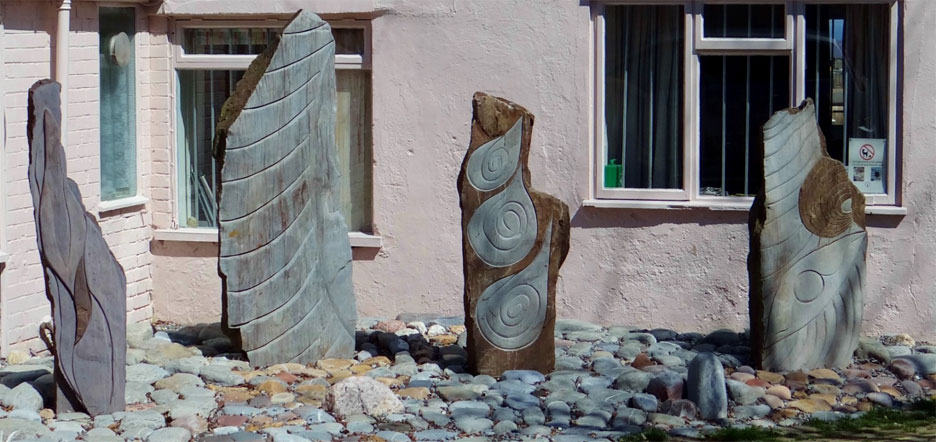Standing Stones
The 'Standing Stones' on the corner of Esplanade Lane were conceived and implemented by the Watchet Conservation Society in association with Watchet sculptor David Milton.
This impressive and enigmatic piece stands on the site of a blacksmith's forge which was located here until the first half of the twentieth century. Mervyn Parsons, a local resident, has memories of both his father and grandfather working here as blacksmiths.

It could be argued that the earliest forms of sculpture found in Great Britain are the numerous standing stones found throughout the country and dating back to the bronze age. These landmarks are shrouded in mystery and have fascinated us through the centuries, their exact purpose lost in the mists of time. Dame Barbara Hepworth, one of the greatest sculptors of the 20th. Century, certainly took inspiration from the stones on Dartmoor for some of her work, produced at her studio in St. Ives, Cornwall.
David's work also relates to these tangible reminders of our early ancestors.
Much of his work is open to interpretation, although it does contain some aspects of symbolism - the 'Seascape' piece is overtly inspired by our immediate coastline.
He has long had a deep fascination for our beaches, 'where the land meets the sea', and regularly visits the beach. He has a considerable understanding of the geological strata and their history - the distinctive alabaster seams that for centuries have been utilized for carving and sculpture. The font at St. Peter’s church in Williton is made of Watchet alabaster and is dated 1666. The cliffs are a rich source of fossils which pre-date the age of the dinosaurs and those with a keen eye may well find an ammonite or 'devil's toe-nail' as they stroll across the beach (which is an S.S.S.I.)
David is aware of the changing weather patterns, the wind, the sun and moon, the ebbing and flowing of the tides and the many other aspects of what is a constantly varying landscape...a landscape that is always inhabited by the many birds which rely on this part of the coast for their continued existence. These elements and more are recurring themes in much of his work.
The stone used in making this work was taken from inland Dulverton.
Each individual stone relates to the others, creating a sense of the perpetual changing of the seasons, a little different perhaps from a woodland, where the variations are much more obviously visual - although for David, the cliffs, beach and the sea, along with the inhabitants, indicate a changing pattern as markedly as an oak tree!
It is worth taking the time to stand in front of the sculpture and attempt to create this connection. Certainly it is the sculptor's intention that the viewer should find what he can, there being no specifics of interpretation. As with more ancient stones many feel a desire to reach out and touch them, this is an important element in his work and is encouraged. It is David's intention that this sculpture is tactile and if visitors feel a need to make a physical contact they will leave their own personal mark for centuries to come.
David Milton has that rare talent who is able to create work of a high degree of sophistication, yet has received no formal art training and is unaware of any artistic influence. His work has been acclaimed by critics and is held in numerous private collections throughout Great Britain and abroad. He has also accepted public commissions including ‘Seascape’ which will remain a constant testimony to his gifts and continue to give Watchet great pride that he has made our town his home. David continues on his sculptural voyage of discovery and could well be on the beach among the rocks as you read this.
Nick Cotton 2013
